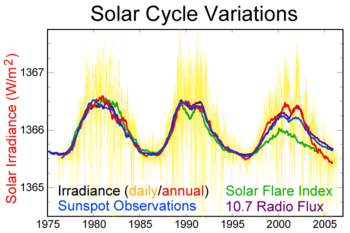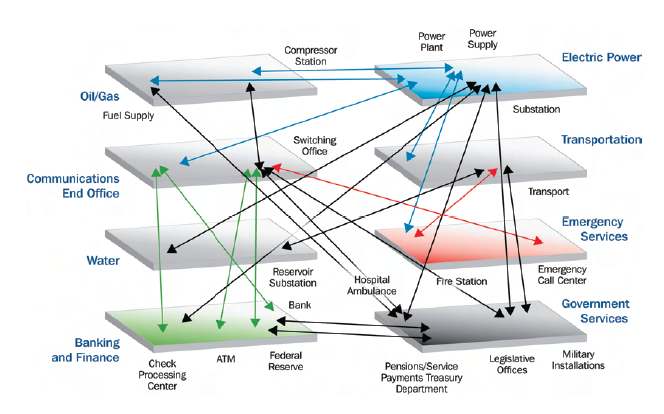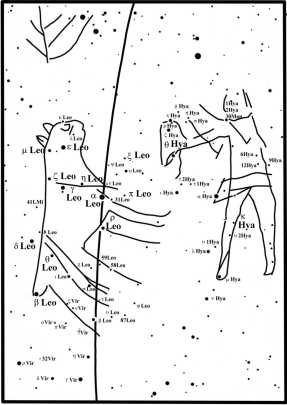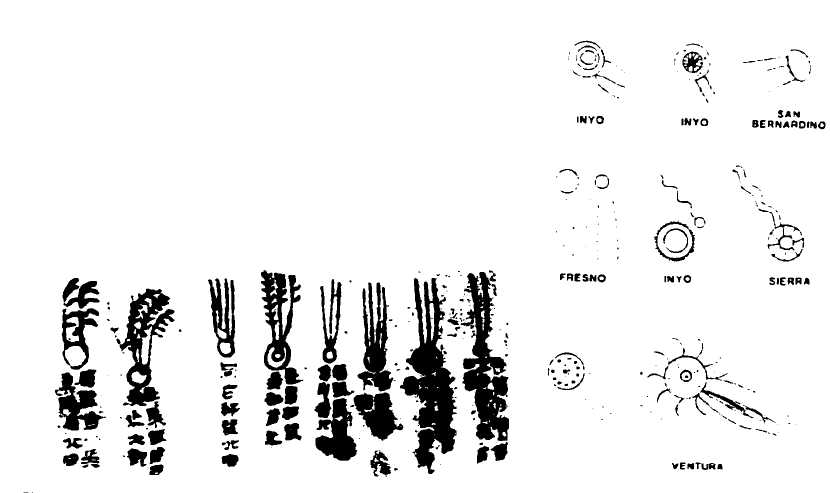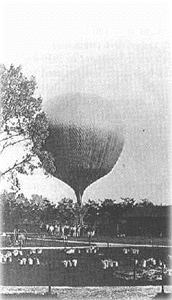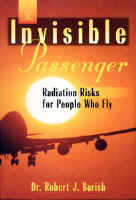Solar Storms in a Nutshell
Our Sun has a cycle of roughly 11 years. At the maximum/peak there are many more sunspots than at the minimum, and 50 times as many solar flares. The next maximum is due in late 2012 / early 2013.
Solar flares are sometimes accompanied by solar proton events and coronal mass ejections (see below). CMEs that are directed towards Earth can interact with our planet’s magnetic field to produce a geomagnetic storm. Not every solar storm will produce all three elements but the largest solar storms typically do.
The Components of a Solar Storm
This is the normal pattern of events
Solar Flares
Arrival Time: 8 minutes (speed of light)
Effect Duration: 1-2 hours
Harm: Electromagnetic radiation in the form of X-rays, extreme ultraviolet rays, gamma ray radiation and radio bursts. They can disrupt radar, satellite communications and radio.
Solar Proton Event
Arrival Time: 15 minutes to a few hours
Effect Duration: Days
Harm: Cosmic Rays which can cause satellite disorientation, spacecraft electronics damage, spacecraft solar panel degradation, extreme radiation hazard to astronauts, high altitude aircraft radiation, shortwave radio fades and disruption in polar regions, ozone layer depletion, cardiac arrest, dementia and cancer.
Coronal Mass Ejection
Arrival time: 2 or 4 days
Effect Duration: Days
Harm: CMEs consist of gas and charged plasma of energy particles A flood of charged particle and electrons in the ionosphere flow from west to east, inducing powerful electrical currents in the ground that surge through natural rock. CMEs can have the following affects: radar errors, radio anomalies, compass errors, electrical power blackouts, oil and gas pipeline corrosion, phone line & equipment damage, electrical shock hazard, electrical fires, heart attacks and strokes. CMEs are also the cause of auroras.
Source: Solar Storm Threat Analysis
Solar Storms of the last 150 years
Here are a few examples of modern harm from solar storms, followed by the most famous storm to date. More details can be found at SolarStorms.org
- 1921 – Telegraph system down west of the Mississippi, Central New England railroad station destroyed by fire
- 1942 – Allied radar disrupted during WW2
- 1972 – Transformer explodes in British Columbia
- 1984 – Air Force One loses communications en route to China
- 1989 – Quebec power outage
- 1989 – Toronto stock exchange computers crash
- 1994 – Canada’s Anik E1 satellite goes off air for 7 hours, affecting news and telephone services. Then Anik E2 goes off air for good
- 2011 – On Valentine’s Day some radio communications were lost, causing some polar flights to be re-routed
September 1, 1859 – The Carrington Event
Just before noon… English astronomer Richard C. Carrington was sketching a curious group of sunspots—curious on account of the dark areas’ enormous size. At 11:18 a.m. he witnessed an intense white light flash from two locations within the sunspot group. He called out in vain to anyone in the observatory to come see the brief five-minute spectacle, but solitary astronomers seldom have an audience to share their excitement. Seventeen hours later in the Americas a second wave of auroras turned night to day as far south as Panama. People could read the newspaper by their crimson and green light. Gold miners in the Rocky Mountains woke up and ate breakfast at 1 a.m., thinking the sun had risen on a cloudy day. Telegraph systems became unusable across Europe and North America.
from Scientific American, Aug 2008
In New York thousands of people lined the streets to view the auroral display, which was seen across North America:
From August 28 through September 4, auroral displays of extraordinary brilliance were observed throughout North and South America, Europe, Asia, and Australia, and were seen as far south as Hawaii, the Caribbean, and Central America in the Northern Hemisphere and in the Southern Hemisphere as far north as Santiago, Chile.
from Severe Space Weather Events
Remarkably, in some U.S. telegraph offices, operators disconnected the batteries and sent telegraphs using only the current induced by the aurora. But then life went on as usual and the Carrington Event was soon forgotten about. Even for scientists it was a curiosity, about as important as studying the seventh wave at the seashore… and it is only recently that this curiosity has been considered a serious threat to our lives.
The Sun Can Harm Our Infrastructure
Since 1859 we have seen the arrival of electronics, and with time our reliance on electronics has grown exponentially. A massive solar storm can harm our electrical grids, without which electronic products cannot operate (unless they run on batteries). Apart from some relatively minor events, the Sun has not yet attacked our grids, but that could just be good luck.
In a primary sense, a repeat of the Carrington Event would most likely cause the following damage:
Power Grids – in March 1989 an X15 flare caused the entire Hydro Quebec system to blackout, with 6 million customers going without electricity for between 9 hours and several days. During the last solar maximum of 2000/2001, NASA estimates that the wholesale cost of electricity in the USA rose by $500 million to cover the costs of solar storm damage.
Railway Tracks – the tracks are long metal conductors. Currents from a CME can damage signaling systems and ignite fires in railroad control stations.
Oil and Gas Pipelines – can suffer from corrosion and potentially failure.
Telephone Land Lines and Undersea Cables – like railway tracks and pipelines, phone lines and cables are also conductors. The induced current (from a CME) can damage transmission lines and any attached equipment tied to those lines. It can also cause equipment fires and people could receive severe electrical shocks.
Satellites – as an example, Japan’s Advanced Satellite for Cosmology and Astrophysics stopped functioning due to a solar storm in July 2000, and due to power losses it crashed to Earth eight months later. A bigger storm will likely knock out more satellites, including those that provide communications and GPS.
Radio and GPS – an x17 flare in Oct 2003 disrupted GPS functionality. According to the US Navy’s report, “the FAA’s Wide Area Augmentation System (WAAS), which uses GPS for aircraft navigation, was seriously impacted during the severe storms on October 29 and 30, and resulted in commercial aircraft being unable to use the WAAS for precision approaches.”
But the flow on effect would be substantial. Homeland Security created this graphic that is really just a brief overview of how inter-connected these things are:
Here are just some of things we’d need to live without:
Infrastructure – banks won’t be able to operate, nor will ATMs – they also use GPS for timestamping transactions. Traffic lights won’t work, causing traffic jams initially. Police and emergency services will struggle to communicate. Empty store shelves will not be refilled. Almost everyone will be unable to work their regular job.
Water – some cities have gravity-fed water available, but in most places we rely on electrical pumps to get water to our homes. Electricity is also needed at water purification plants. Apart from drinking water, consider that we use it to wash, to flush toilets, and to move sewage away from our homes. Without electricity many sewage plants will not operate normally.
Heating and Cooling – the loss of these could kill people during the winter and summer months.
Energy and Fuel – pipelines can fail, and the normal way to access stored fuel is with an electric pump. While manual pumping might get gasoline out at a gas station, the authorities or thugs will likely be in control.
And then there’s a special danger:
Nuclear Power Plants – without electricity there’s only diesel generators to keep the plant cool and avoid meltdown. It would not be surprising if the amount of diesel on hand is low, and the ability to obtain more or even ask for more could be low in a dark USA.
Put all the above together and you invoke the butterfly effect… one example is that crime will increase, due to looting. To keep the peace, looters would need to be arrested and jailed. But to operate jails with no electricity becomes problematic – no video surveillance, difficulties in providing food and water and so on – which means a lot more police need to be deputized, removing able-bodied men from other useful tasks. A police chief might decide that looting is a hanging offence…
Why Are Power Grids Vulnerable?
Large transformers are electrically grounded to Earth and thus susceptible to damage caused by geomagnetically induced directcurrent (DC). The DC flows up the transformer ground wires and can lead to temperature spikes of 200 degrees Celsius or higher in the transformer windings, causing coolant to vaporize and literally frying the transformer. Even if transformers avoid this fate, the induced current can cause their magnetic cores to saturate during one half of the alternating-current power cycle, distorting the 50- or 60-hertz waveforms. Some of the power is diverted to frequencies that electrical equipment cannot filter out. Instead of humming at a pure pitch, transformers would begin to chatter and screech. Because a magnetic storm affects transformers all over the country, the condition can rapidly escalate to a network-wide collapse of voltage regulation. Grids operate so close to the margin of failure that it would not take much to push them over.
According to studies by John G. Kappenman of Metatech Corporation, the magnetic storm of May 15, 1921, would have caused a blackout affecting half of North America had it happened today. A much larger storm, like that of 1859, could bring down the entire grid. Other industrial countries are also vulnerable, but North America faces greater danger because ofits proximity to the north magnetic pole. Because of the physical damage to transformers, full recovery and replacement of damaged components might take weeks or even months.Kappenman testified to Congress in 2003 that “the ability to provide meaningful emergency aid and response to an impacted population that may be in excess of 100 million people will be a difficult challenge.”
The U.S. Congress has voted against providing funding that would harden the power grid and eliminate the possibility of a massive failure. It could be the worst decision they ever made.
Other power grids that are reasonably close to the poles, such as Europe, Russia, Australia, Argentina and South Africa are also at risk.
What Are The Odds?
Scientists guesstimate that a solar storm with the magnitude of the Carrington Event will only happen once every 500 years (based on nitrates found in ice cores representing the last 450 years). Storms with half its intensity should hit every 50 years or so. The last one occurred on November 13, 1960, and led to global geomagnetic disturbances and radio outages. The next is due now, at a time when satellites are substantially more important, and power grids are more vulnerable. Larger storms than the Carrington Event will also happen, although we don’t know how frequently. One model has shown that a storm 1000 times as strong is possible.
Heart Attacks and Strokes
Amazingly, studies have shown that during solar storms the frequency of hospital admissions for heart attacks and strokes is roughly double that of quiet solar periods. Magnetic pulses are thought to be the cause. Geomagnetic storms have also been linked to depression, enhanced anxiety, sleep disturbances, altered moods and psychiatric admissions (up 36%). Presumably there would be far greater increases during a storm like the Carrington Event.
Are We Prepared?
NOAA’s Space Weather Prediction Center provides daily space weather reports (their data appears at SpaceWeather.com) to businesses and government agencies. Its annual budget is a mere $6 million. It does provide advance warnings so that businesses can take precautionary measures, but there is a great deal of variability between their predictions and the actual damage that can occur. And with a Carrington-type event, the warning provides a mere 10-minute window in which to act.
When warning us about incoming geomagnetic storms, the NOAA’s only source of data is the Advanced Composition Explorer (ACE) satellite. It was launched in 1997, and according the the U.S. National Academy of Sciences in 2009, it is “well beyond its planned operational life”. I take this to mean it could fail any time, and there is no backup satellite! And all current safety measures become redundant – we won’t be able to remove vulnerable equipment from the grid before it is too late. “ACE is a single point of failure and it’s old,” said William Murtagh, program coordinator for NOAA’s Space Weather Prediction Center. “Every time I have a space weather storm I cringe a little bit that our very own space weather satellite doesn’t succumb to the storms I’m relying on it to help forecast.”
Power grids are prepared to some degree. The Hydro Quebec blackout of 1989 was due to circuit breakers shutting down the system before the flare could fry transformers. It is not known how dependable such safety systems are, for they have not been sufficiently put to the test. And of course human error is easily possible. The decision of when and how to shut down an electrical system might come down to one or two individuals. They might delay the shut-down too long, or they might think their jobs were at risk if they mistakenly switched off power to entire cities. The devastating Queensland floods of 2011 were the result of a similar type of human error – and they had days to make their decisions, not ten minutes.
Several million Preppers are prepared for this and various other catastrophes. That leaves hundreds of millions of Americans who are not prepared, as well as governments and infrastructures that have not made provisions for long-term losses of electricity.
Official Vulnerability Estimate
The following quote is from Severe Space Weather Events, a report commissioned by the National Research Council.
Severe space weather has the potential to pose serious threats to the future North American electric power grid. Recently, Metatech Corporation carried out a study under the auspices of the Electromagnetic Pulse Commission and also for the Federal Emergency Management Agency (FEMA) to examine the potential impacts of severe geomagnetic storm events on the U.S. electric power grid. These assessments indicate that severe geomagnetic storms pose a risk for long-term outages to major portions of the North American grid. John Kappenman remarked that the analysis shows “not only the potential for large-scale blackouts but, more troubling, . . . the potential for permanent damage that could lead to extraordinarily long restoration times.” While a severe storm is a low-frequency-of-occurrence event, it has the potential for long-duration catastrophic impacts to the power grid and its users. Impacts would be felt on interdependent infrastructures, with, for example, potable water distribution affected within several hours; perishable foods and medications lost in about 12-24 hours; and immediate or eventual loss of heating/air conditioning, sewage disposal, phone service, transportation, fuel resupply, and so on. Kappenman stated that the effects on these interdependent infrastructures could persist for multiple years, with a potential for significant societal impacts and with economic costs that could be measurable in the several-trillion dollars-per-year range.
…The least understood aspect of this threat is the permanent damage to power grid assets and how that will impede the restoration process. Transformer damage is the most likely outcome, although other key assets on the grid are also at risk. In particular, transformers experience excessive levels of internal heating brought on by stray flux when GICs cause a transformer’s magnetic core to saturate and to spill flux outside the normal core steel magnetic circuit. Kappenman stated that previous well-documented cases have involved heating failures that caused melting and burn-through of large-amperage copper windings and leads in these transformers. These multi-ton apparatus generally cannot be repaired in the field, and if damaged in this manner, they need to be replaced with new units, which have manufacture lead times of 12 months or more.
…In summary, present U.S. grid operational procedures are based largely on limited experience, generally do not reduce GIC flows, and are unlikely to be adequate for historically large disturbance events. Historically large storms have a potential to cause power grid blackouts and transformer damage of unprecedented proportions, long-term blackouts, and lengthy restoration times, and chronic shortages for multiple years are possible. As Kappenman summed up, “An event that could incapacitate the network for a long time could be one of the largest natural disasters that we could face.”
Finally, I can recommend this Feb 2012 article from the IEEE, which concludes ” If we do nothing—if we stand by and wait for politicians to appreciate the risks and act on them—we may witness one of the worst catastrophes of all time”
http://spectrum.ieee.org/energy/the-smarter-grid/a-perfect-storm-of-planetary-proportions/0


